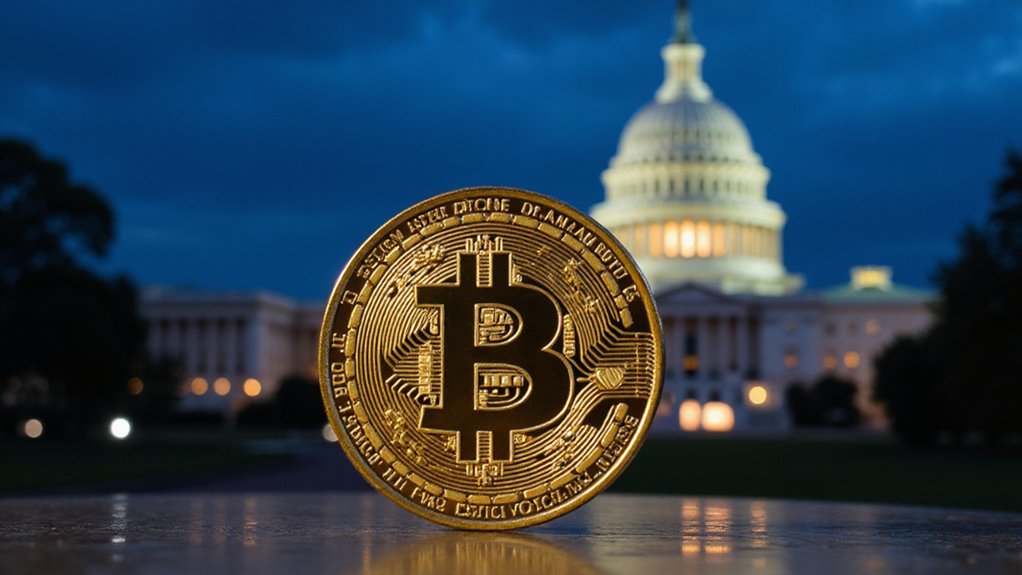DeFi (decentralized finance) represents a blockchain-based alternative to traditional financial systems, operating without centralized intermediaries like banks. Built primarily on Ethereum, DeFi utilizes smart contracts to enable lending, trading, and investing through platforms like Uniswap and Aave. With $130 billion currently locked in protocols and projections of $800 billion by 2027, DeFi offers permissionless access, faster settlements, and community governance. The following guide unpacks this financial transformation reshaping global markets.

While traditional financial systems have dominated global markets for centuries, decentralized finance (DeFi) represents a paradigm shift in how people interact with money and financial services. Built on blockchain technology, primarily Ethereum, DeFi creates an ecosystem of peer-to-peer financial applications that operate without centralized intermediaries like banks or brokerages. These applications utilize smart contracts—self-executing code that automatically enforces agreements when predetermined conditions are met.
The DeFi ecosystem encompasses several key components that mirror traditional finance but with improved accessibility and efficiency. Decentralized exchanges (DEXs) like Uniswap enable users to swap tokens directly from their wallets without third-party involvement. Lending protocols such as Aave and Compound allow individuals to earn interest by providing liquidity or borrow assets by posting collateral. Stablecoins, pegged to fiat currencies, provide stability in the volatile crypto market while maintaining the benefits of blockchain technology. DeFi empowers users with open, fair markets that democratize financial access globally. Similar to traditional cryptocurrency exchanges, many DeFi platforms require KYC verification to ensure regulatory compliance and user security.
DeFi reimagines traditional financial services with greater accessibility, enabling direct token swaps, interest-earning opportunities, and stable digital assets—all without intermediaries.
The appeal of DeFi stems from its fundamental characteristics: permissionless access, transparency, and efficiency. Users worldwide can access financial services regardless of geographic location or socioeconomic status. Transactions occur faster than traditional finance, often settling in minutes rather than days. The open-source nature of DeFi protocols guarantees transparency, allowing users to verify how applications function and interact with their funds. Governance tokens enable users to participate in protocol decision-making, creating truly community-driven financial systems.
Market data demonstrates DeFi's remarkable growth trajectory. With $130 billion locked in various protocols as of 2024, projections indicate the market could reach $800 billion by 2027. Institutional adoption continues to accelerate as traditional financial entities recognize DeFi's potential to reduce operational costs and expand service offerings.
Despite its advantages, DeFi presents significant challenges. Smart contract vulnerabilities have led to numerous hacks and security breaches. Regulatory frameworks struggle to keep pace with innovation, creating uncertainty for users and developers. The technical complexity of DeFi platforms often creates barriers to mainstream adoption, requiring specialized knowledge to navigate safely.
Looking toward 2025 and beyond, several trends are shaping DeFi's evolution. Cross-chain interoperability solutions are breaking down barriers between different blockchains. Real-world asset tokenization is bringing traditional assets like real estate and commodities on-chain. Decentralized insurance protocols are emerging to mitigate risks inherent in the ecosystem.
As DeFi matures, the focus on user experience, security, and regulatory compliance will likely determine its path to wider adoption.
Frequently Asked Questions
How Will Defi Regulations Evolve by 2025?
By 2025, DeFi regulations will crystallize around four key pillars:
regulatory clarity with standardized stablecoin rules and legal definitions of decentralization;
integrated compliance tools with mandatory audits and reporting requirements;
consumer protection mechanisms including insurance schemes and risk disclosures;
and cross-border coordination through international sandboxes and harmonized tax treatments.
These frameworks will balance innovation protection with systemic risk management, creating a more stable DeFi ecosystem while maintaining its core benefits.
What Insurance Options Exist for Defi Investments?
DeFi insurance options protect investors against various protocol risks. Major providers include Nexus Mutual, InsurAce, and Bridge Mutual, offering coverage for smart contract failures, hacking incidents, stablecoin depegs, and oracle failures.
These solutions operate through risk pools where users pay premiums, with claims typically governed by token holder votes.
Despite growing rapidly, the industry's $500M+ total value locked remains limited compared to the overall $50B+ DeFi ecosystem.
Can Defi Protocols Operate Without Governance Tokens?
Yes, DeFi protocols can operate without governance tokens. Several prominent examples exist, including Bitcoin and Uniswap v1, which rely on hard-coded parameters and developer-led decision-making.
These protocols often utilize alternative governance structures such as multi-signature wallets or time-locked upgrades. While this approach offers advantages like simplified design and reduced regulatory scrutiny, it faces challenges including limited community participation and centralized control.
Some projects implement hybrid models combining algorithmic rules with minimal governance intervention.
How Do Traditional Banks View Defi Competition?
Traditional banks view DeFi with a mix of caution and strategic adaptation. Financial institutions monitor blockchain developments while developing competitive responses through their own digital currencies and fintech partnerships.
Banks actively advocate for stricter DeFi regulations, emphasizing consumer protection concerns in unregulated platforms. Simultaneously, many institutions are exploring hybrid models that combine DeFi innovations with traditional banking frameworks.
Some forward-thinking banks are investing in DeFi startups and developing institutional-grade custody solutions for digital assets.
What Environmental Impacts Do Defi Networks Have?
DeFi networks' environmental impact varies significantly by underlying blockchain. Proof-of-Work systems consume substantial energy, with Bitcoin generating approximately 55 million tons of CO2 annually.
Conversely, Proof-of-Stake networks like Ethereum reduced energy usage by over 99%.
Electronic waste remains problematic, with Bitcoin producing an estimated 10.52 kilotons annually from outdated mining equipment.
Sustainability initiatives include adopting Layer-2 scaling solutions, developing efficient smart contract platforms, and investing in renewable energy sources.
References
- https://www.coinbase.com/learn/crypto-basics/what-is-defi
- https://goodcrypto.app/what-is-defi-in-crypto/
- https://www.coinbase.com/learn/crypto-basics/plp-what-is-defi
- https://www.investopedia.com/decentralized-finance-defi-5113835
- https://www.bankrate.com/investing/what-is-decentralized-finance-defi-crypto/
- https://www.coursera.org/articles/what-is-defi
- https://cryptoslate.com/what-is-defai-the-ai-enabled-defi-narrative-looking-to-take-2025-by-storm/
- https://n26.com/en-eu/blog/what-is-defi
- https://coincrowd.com/blogs/how-defi-could-evolve-in-2025-what-investors-need-to-know
- https://complexdiscovery.com/regulatory-challenges-and-legal-battles-the-irs-defi-and-fintech-scrutiny-in-focus/





